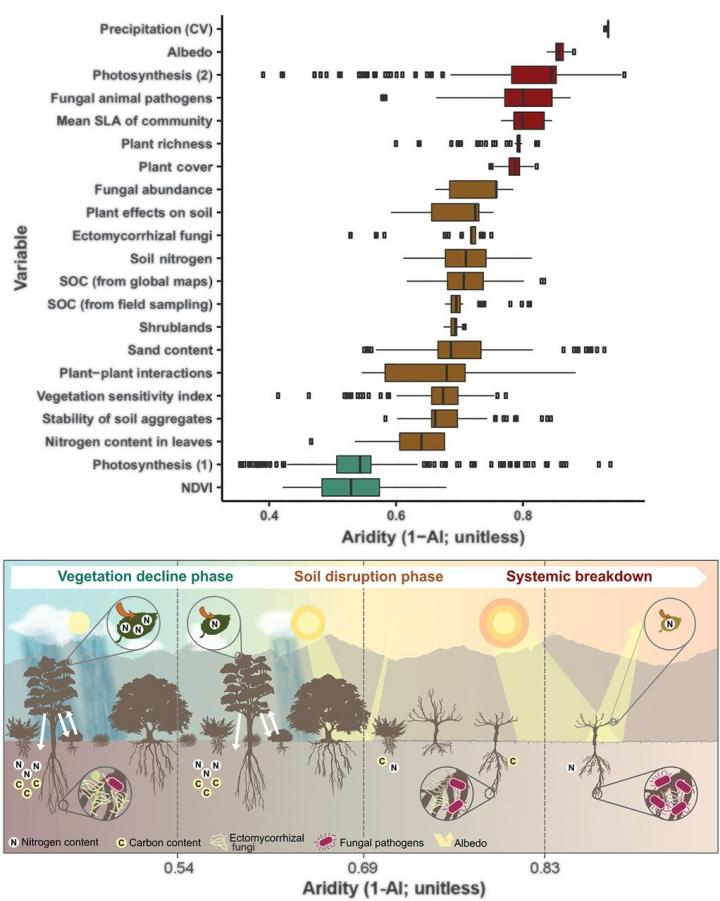By Matt Pullen, B.Sc.Feb 17 2020
A major study by a Swansea University academic shows that elevated aridity in certain parts of the world may cause sudden changes in ecosystems in regions where over two billion people live. The study has been published in the Science journal.
 Sequence of abrupt responses in global drylands as aridity increases. Image Credit: Berdugo et al.
Sequence of abrupt responses in global drylands as aridity increases. Image Credit: Berdugo et al.
Dr. Rocio Hernandez-Clemente, a senior lecturer from the Department of Geography of Swansea University, collaborated with an international research team from the Dryland Ecology and Global Change Lab at the University of Alicante to investigate the Earth’s dryland ecosystem. The dryland ecosystem encompasses 41% of the world’s surface, where about one-third of Earth’s population lives.
For the first time, the study discovered that due to increases in aridity, dryland ecosystems experience a sequence of sudden changes. Initially, this leads to substantial reductions in the ability of plants to fix carbon from the atmosphere. Then, there is a steep decline in soil fertility, eventually leading to the disappearance of vegetation under the most extreme and arid conditions.
Climate Change and Ecosystems
The researchers discovered that aridity increase associated with current climate change forecast might cause sudden changes in dryland ecosystems across the globe, which restricts their ability to sustain life. This is because climate predominantly governs the amount and kinds of plants that grow in a specified place, the fertility of the soil, and the appearance of landscapes.
To predict and mitigate the effects of climate change on both ecosystems and societies, it is essential to understand how changes in climatic conditions impact organisms and the ecosystem processes and services that rely on them, for example, the production of food and biomass.
The Study
Headed by Dr. Miguel Berdugo, from the University of Alicante, the researchers collected the most extensive set of empirical data available thus far to assess how important ecosystems change along the broad aridity gradients found in drylands across the globe.
Dr. Hernandez-Clemente carried out an essential part of the data extraction, processing the Normalized Difference Vegetation Index data analysis of 60,000 points distributed across the world. This was used as an indicator of the productivity of plants in drylands. In addition, she took part in the quality evaluation analysis and data validation and also derived trends to identify sudden shifts using remote sensing data.
The purpose of our work was to look at how these ecosystem change as we move towards more arid zones in order to better understand what we may expect in the future as the climate becomes drier, and more arid, in drylands worldwide.
Dr Miguel Berdugo, Researcher, University of Alicante
As part of the study, three phases of accelerated ecosystem change caused by increases in aridity were identified. These were quantified as the inverse ratio of rainfall with the rate of evaporation of water from the land to the atmosphere. In drylands, this index ranges between 0.35 and 1, where greater values of the index suggest more severe conditions in terms of the availability of water.
Key Findings
Listed below are the main findings of the study:
- In drylands, essential ecosystem functions and attributes respond to increases in aridity in a nonlinear way.
- If the increase in aridity reaches beyond a value of 0.5, there is an acceleration in the loss of productivity with more increases in aridity.
- If the increase in aridity reaches beyond values of 0.7, the soil abruptly loses its structure and turns more susceptible to erosion.
- There is also a negative impact on soil organisms that play crucial roles in maintaining the function of the ecosystem.
- The occurrence of pathogens considerably increases at the expense of more advantageous organisms.
- If the increase in aridity reaches beyond a threshold value of 0.8, the system breaks down, plants cannot grow, and the land turns into a desert.
Climatic forecasts show that by 2100, over 20% of land may cross one or many of the thresholds recognized in this study because of climate change.
Life will not disappear from drylands with forecasted aridity increases, but our findings suggest that their ecosystems may experience abrupt changes that will reduce their capacity to provide ecosystem services more than 2 billion people, such as soil fertility and biomass production.
Dr Miguel Berdugo, Researcher, University of Alicante
According to Dr. Rocio Hernandez-Clemente, “The reduced global ability of the land to sustain life is predicted to become an increasing problem with climate change. This study demonstrates the possibility of detecting abrupt changes and monitoring how land turns into desertification processes with remote sensing data.”
The use of satellite image data helps scientists to monitor, predict and quantify the consequences of the increasing aridity in drylands ecosystems worldwide. International cooperation is essential for assessing land degradation and abrupt shifts. The next steps of our research will be focused in the use of earth observation data for look for changes of desertification processes.
Dr Rocio Hernandez-Clemente, Senior Lecturer, Department of Geography, Swansea University